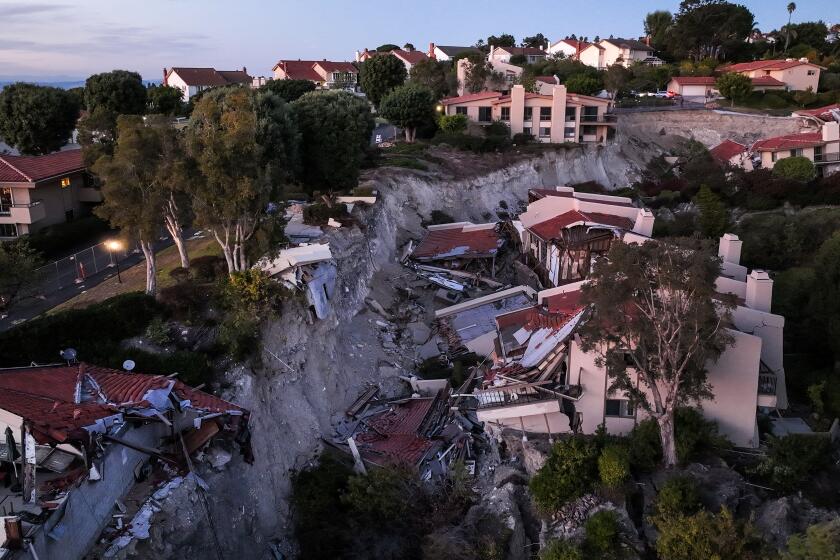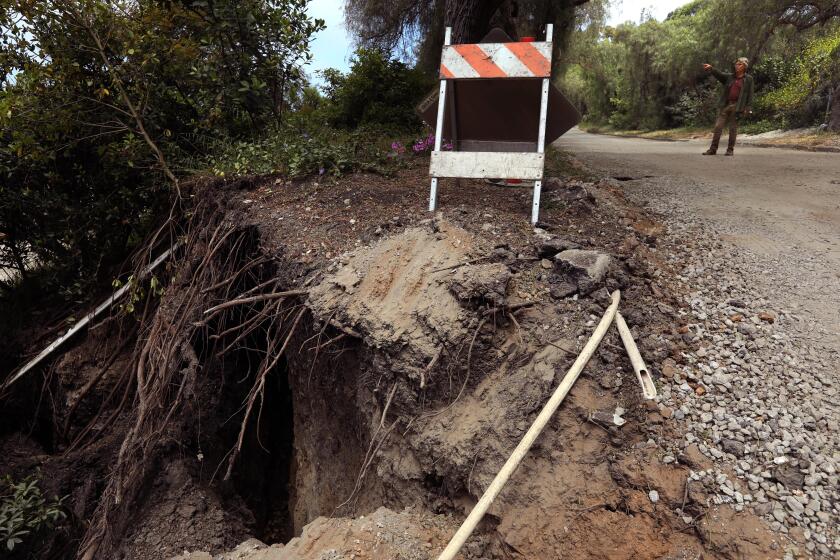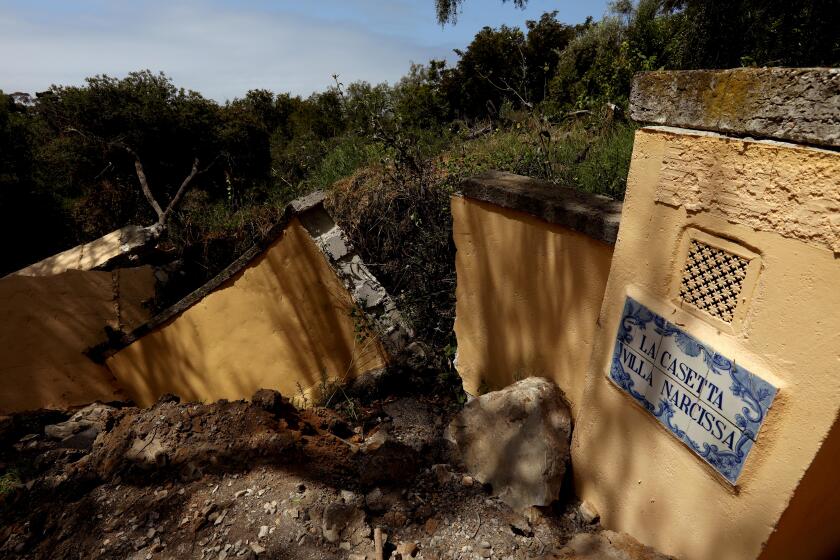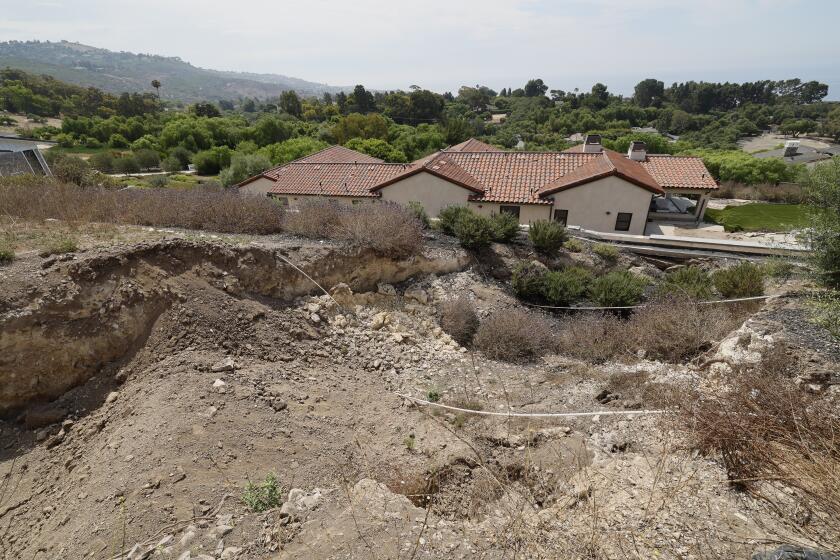Homebuyers beware: How to avoid properties with high landslide risk
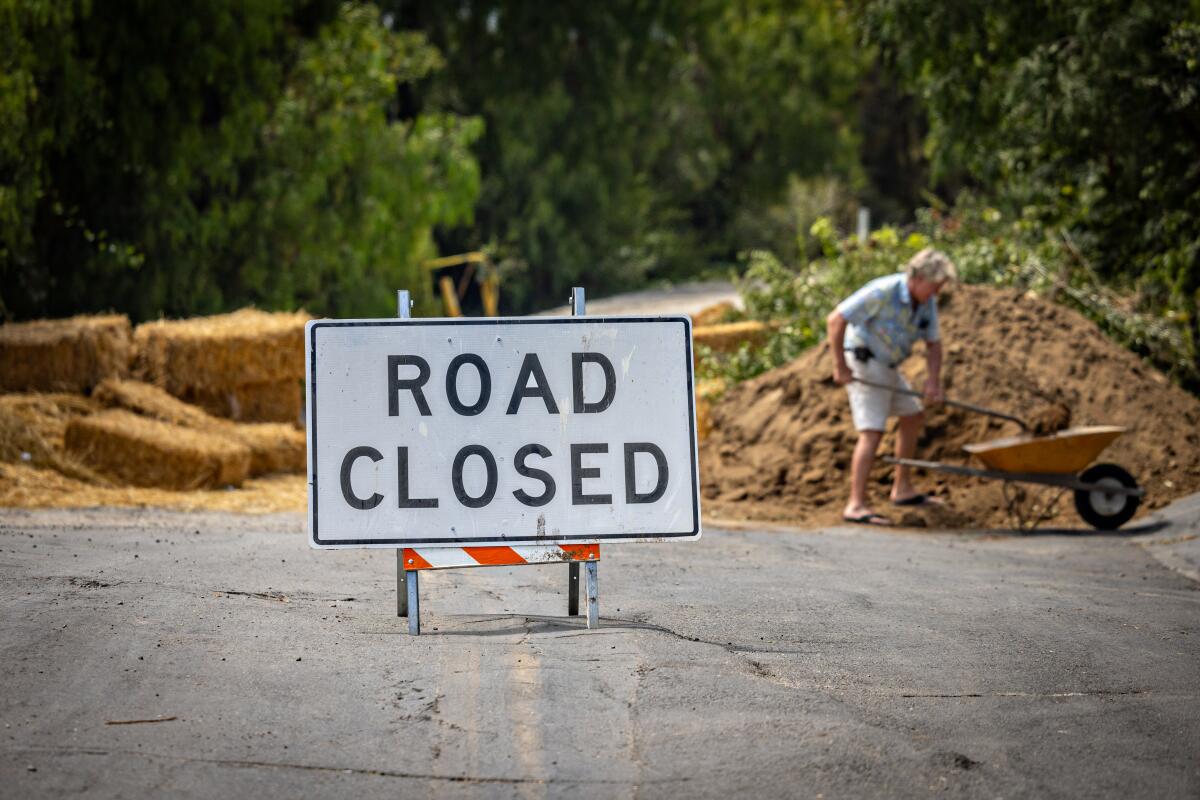
- Share via
The landslides that have forced authorities to shut off power and gas to hundreds of homes in Rancho Palos Verdes over the last two months highlight the risk of living on land susceptible to shifting and eroding with little warning.
Deep-seated landslides can occur weeks or months after heavy rainfall, when water has time to percolate down to weak zones of rock, creating a landslide plane under the weight of the overlying rock and soil, according to the California Geological Survey.
These types of landslides generally occur on moderately steep slopes.
If you are in the market to buy a home, experts say there are a few ways to determine whether you are buying a property with a high risk of landslides.
It came as a shock when a landslide destroyed homes in Rolling Hills Estates last July. But research from UCLA and NASA shows that land movement preceded the catastrophe.
What causes landslides
Landslides are part of the natural process that erodes mountains and moves sediment to the ocean through river systems. “It’s important to the basic erosion process,” said Jonathan Godt, the landslide hazards program coordinator for the United States Geological Survey.
“Over the human lifespan, we’re just a blink of an eye in geological time, so [landslide] issues or those processes don’t penetrate our consciousness until something like the unfortunate situation in Rancho Palos Verdes happens,” he said.
In 2011 the California Geological Survey created a map that shows that a majority of the state’s coast is at risk of landslides.
Homes built decades ago on ancient landslides that were at one time dormant are “fine for periods of time, [but] sometimes there are changes,” Godt said.
Several factors can alter a landslide’s active status, such as rainfall and earthquakes, but the warning signs are hard to see because they are “well beneath our feet and kind of hidden,” he said.
When properties in these areas are for sale, it’s up to buyers to gauge the land movement risk of the property they’re interested in.
If the seller or their agent knows that the property is on a seismic hazard zone that is subject to strong ground shaking, soil liquefaction or landslide, the information must be disclosed, according to the state Department of Real Estate.
But buyers are also responsible for conducting their own research.
New drilling in Rancho Palos Verdes has revealed that devastating land movement has been caused, at least partially, by a deeper slip plane — meaning a larger area could be affected.
Online research into a property’s landslide risk
At least two websites, Realtor.com and Redfin.com, provide information on the property’s natural disaster risk. Near the bottom of the listing there’s a section that breaks down the property’s risk of flooding, fires, heat, wind and air. Unfortunately, landslides and land movement are not factors that are disclosed.
Instead, potential buyers should conduct a Google search of the neighborhood alongside the words “landslide” or “natural disaster.” If there has been previous landslide activity, news articles about those problems probably will surface, said Timothy D. Stark, professor of civil and environmental engineering at the University of Illinois.
For more scientific data, buyers can turn to three landslide maps created by the California Geological Survey. The Reported Landslides Database has reports of landslides from local governments, the National Weather Service and citizen scientists. The Landslide Index allows users to request reports and other documentation of landslides in a specific area. The California Deep Landslide Susceptibility and Landslide Inventory includes a map of the state that marks areas of landslide susceptibility in dark red.
The California Department of Conservation also published a 2023 California Landslide Response report that included a page showing where deep-seated landslide activity might occur after the 2023 storms.
Stark also suggested using Google Earth Pro to look at aerial images over time to look for land movement.
When you look up an address or a neighborhood on Google Earth Pro, it will automatically show you the current image. To view past images, click the View tab and then Historical Imagery or click on a small clock icon above the 3D Viewer. You can then zoom in or out to change the start and end dates.
As you look at the surface of the area you’re researching, Stark said to look for ground surface features such as drops in nearby hillsides or reddish areas (that have exposed or no vegetation) that indicate steep slopes — all potential signs of prior slope movement.
Accelerating landslides in Rancho Palos Verdes have continued to upend life. But residents like Gordon Leon aren’t ready to give up.
Looking for signs of past or potential landslide activity
Other signs of landslide risks can be spotted with the naked eye when visiting a property you are looking to buy.
When you’re visiting the neighborhood, take a look at the surrounding properties.
If the house is near or around hills, check out the hill or slope itself. A sign of land movement is if the ridge at the top of the hill is flat and then has a steep curve, a drop or cracks, suggesting a previous landslide.
Check the base of the hill; if the ground is heaved up, that’s a sign of movement.
Consider how close the hill or slope is to the property you’re interested in. If there is sudden land movement or a landslide, the higher the nearby hillside, the farther a landslide can travel, Stark said.
Other signs of past land movement in the area might include:
- Misaligned fencing, pavement, guard rails, utility poles, trees or walls.
- Visible cracks on the ground.
- Water and sewer lines that are above ground.
- A cracked or buckled roadway.
- Offset yellow or white lines on the roadway.
- Houses in the neighborhood that are supported by wooden boards or railroad ties.
- Houses that have cracks or are leaning.
You can also check whether land is moving by taking a photograph of the offset marked lines on the ground or a crack in the pavement and revisit the same site a week or two later to see if there’s any visible difference, Stark said.
If you decide to make an offer for a home and start escrow, a home inspector can help you determine if past land movement has affected the property.
Stark said home inspectors will complete a home assessment and look at the walls, drywall and foundation for any types of cracks that suggest land movement. Inspectors will also look at whether the walls are straight and the floor inside the home is level.
Inspectors can also suggest if a geotechnical engineer is needed to conduct soil samples of the home. These tests can detect the behavior of the ground under varying conditions.
An attorney who represented Rancho Palos Verdes in a lawsuit over development says court decisions forced the city to allow building in the landslide area.
Insurance coverage for landslides?
Natural disasters such as earthquakes, flooding and landslides typically are not covered by a general homeowners insurance policy.
However, homeowners can buy a non-standard policy, called a Difference in Condition policy, that’s often used to cover earthquake damage.
Jerry Becerra, president of Heffernan Barbary Insurance Services, said it’s possible to find a DIC policy covering earthquakes where the definition of earth movement is broad enough to include landslides. But he said such a policy could be pricey.
“Presuming you can find a DIC earthquake policy to cover a building located in an area prone to earth movement, the pricing would reflect the exposure,” Becerra said.
Underwriters rely on maps that show soil conditions, proximity to earthquake faults and other factors to determine rates, he said.
If the area is known to have a lot of earth movement, he said, it’s possible no company would be willing to provide coverage.
“I would not take a guess on actual pricing, but I expect it to be more than 1% of the coverage value and subject to high deductibles,” Becerra said.
More to Read
Sign up for Essential California
The most important California stories and recommendations in your inbox every morning.
You may occasionally receive promotional content from the Los Angeles Times.
